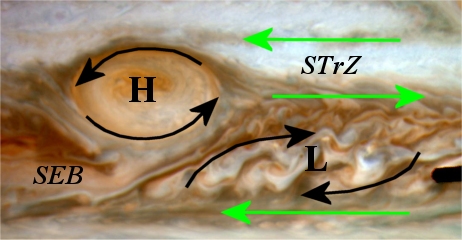2011
apparition - Note n°3
BACK
TO NORMAL IN THE SOUTH EQUATORIAL BELT ?
|
Since the return of
Jupiter in the night sky after the last solar conjunction,
observers have witnessed the revival of the South equatorial belt
(SEB), whose fading had been the major subject during the last
two apparitions of 2009 and 2010. The revival phase of the SEB
has begun in november 2010 but has been developing further during
the year 2011. Some of the usual aspects of the belt when it's in
a "normal" phase of activity did reappear only this
fall - and some are still missing.
The revival
of the GRS "wake" in the SEB
In every atmosphere
of the universe, cyclones and anticyclones are vortices created
by imbalances of pressure or temperature. They allow airmasses to
mix between the poles and the equator - or between the equator
and the tropics... they work with each other - a cyclonic
structure must be accompanied by its high-pressure counterpart.
We know that on Jupiter the GRS is strong, ancient anticyclone.
But where is the low-pressure zone that must exist on its side ?
When the SEB is in
a normal phase of activity, we always see white structures on its
north-following flank inside the SEB. Those spots are convective
eddies, local cumulonimbus that has a short life-time (a few
days). But, if they are short-lived the convective region itself
is permanent and this is where the low-pressure counterpart of
the GRS is, even if it's not organized as a steady vortex like
the NEB barges are for example. This region is often nicknamed
the "GRS wake" by amateurs. During 2011 fall, this
region is reviving strongly, and it's an event in itself because
it had been missing for two years and a half : this convective
turbulence is the first one to stop abruptly when the SEB is
about to fade. This what had been observed in 2009 may or 2007
january. Its revival is as important as its halt ; this is a sign
that may allow us to conclude that the fade and revival cycle of
the SEB that started in 2006 has come to its end.
Schema of the GRS region,
with it associated low-pressure region inside the SEB
The Great
red spot is the high-pressure (H) of the South tropical
zone STrZ. At north-west (north-following), is a SEB
low-pressure region designed "L". Green arrows
draw the jetstreams that mark the STrZ and the SEB. Black
arrows outline the global rotating wind movements.
As it must
be in a southern hemisphere, H is rotating
counter-clockwise and L, in the clockwise sense.
At bottom is
an animation cropped from a Cassini movie that show the
movements. Despite its messy aspect in a still image, the
clockwise movement of the GRS wake is easy to see.
Images (c)
STScL/HST and (c)NASA/JPL/Caltech
|

|

|

|
The revival of the GRS wake in
images
During the
first months of the 2011 apparition (may-august), the
aspect of the SEB north-following of the GRS is still in
the post-revival phase. Despite some further outbreaks
near the source of the original 2010 outbreak farther in
longitude (250-260°), this aspect is characterized by an
absence of big convection, a reddish tint and the
existence of very small red spots (mini barges). The
aspect of the zone in Akutsu's image of 27 june 2011 is
really comparable with the typical aspect depicted in the
1991 march HST shot, also taken months after a SEB
revival. From late september 2011, the situation has been
changing, with the reappearance of white convection just
near the GRS (Yann Le Gall's image). From september to
december 2011, the white spots has been intensifying
quite a lot and many amateurs have noticed them. On Marc
Delcroix's image of october 8th, the region is already
much more active than two weeks ago.
These white
spots show the revival of the low-pressure SEB region
associated to the GRS. Images taken in the methan band
are equally interesting...
|

|
Images taken in the 890 nm CH4
absorption band, showing the phenomenon
CH4 images
reveal that the white spots, being brillant, are of a
relative high altitude. This show their outbreaking
nature - they are local big cumulonimbus. Images taken
during 2011 summer (Peach, Prost) never showed any sign
of brightening there. Yet in october (Pellier, Akutsu),
oubreaks are now showing up. We can also note that the strange CH4
aspect the belt had last summer looks to have darkened. This change, if
confirmed, might also show a slow return to normal of the
SEB.
|
What is
still missing
The persistenced of
the massive grey south tropical belt (in the STrZ) on the
southern flank of the SEB is remarkable, and this is not a normal
aspect of the region. Some others usual phenomenons of the active
SEB are still missing, like the SEBs jetstreams spots that have
not been seen for at least six years now ; and in CH4 the SEB it
still too narrow. The return too "normal" is not
complete and the region deserved to be followed during the coming
months.
Further
lecture
Jupiter well placed for
observing this autumn, BAA
Jupiter's section first report of the 2011 apparition..
2011 Note 1 and Note 2 (in french)
2011/12/04
Christophe Pellier
Jupiter section coordinator
http://www.astrosurf.com/planetessaf/jupiter



